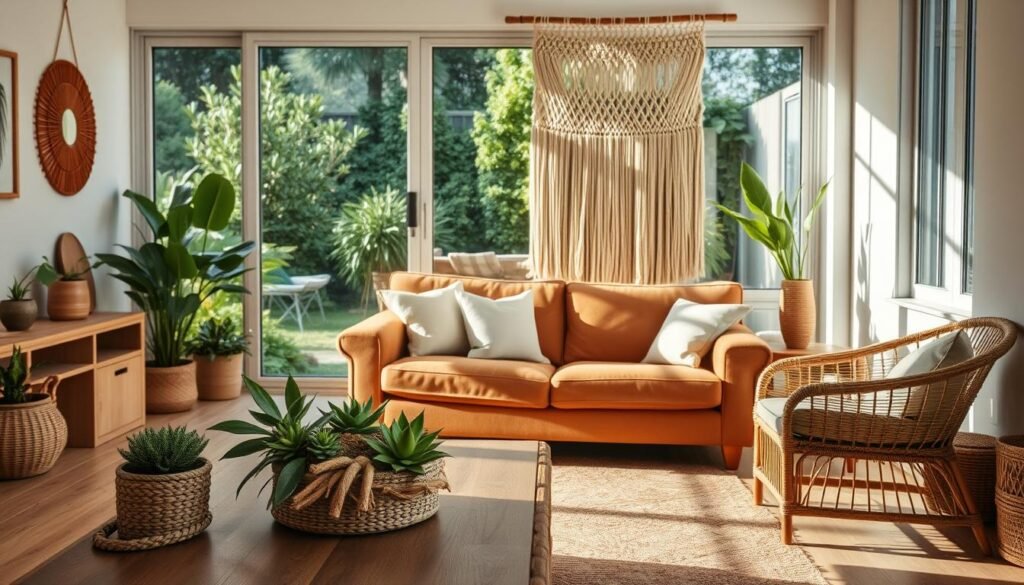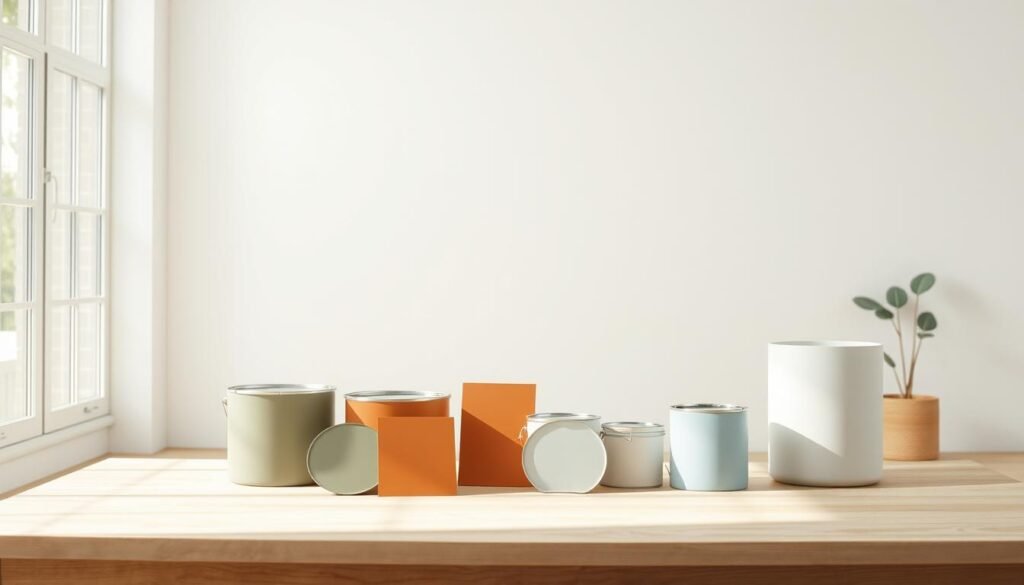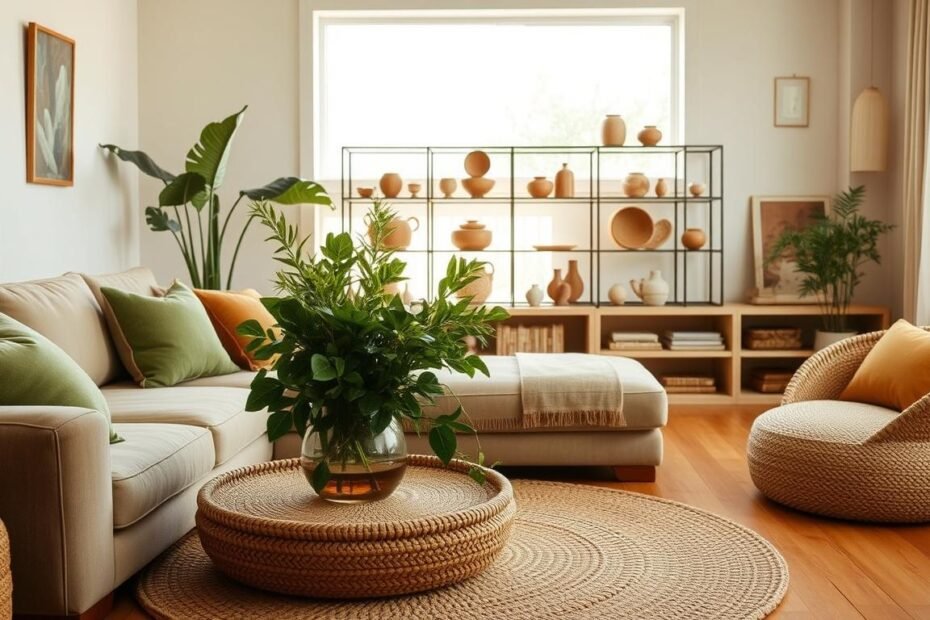What if your home could be stylish and sustainable at the same time? Making environmentally conscious choices doesn’t mean compromising on aesthetics; it means making smarter choices that last.
By incorporating eco-friendly practices into your decor, you can create a beautiful and green space that reflects your personal style.
Key Takeaways
- Make smarter choices that last
- Incorporate eco-friendly practices into your decor
- Create a beautiful and green space
- Adopt greener practices without compromising style
- Environmentally conscious choices are key to a sustainable home
Understanding Sustainable Decor and Its Importance
Embracing eco-friendly design is a significant step towards creating a healthier home and planet. As we become more aware of our environmental footprint, the importance of sustainable decor in our daily lives cannot be overstated. It’s about making conscious choices that not only beautify our living spaces but also contribute to the well-being of the environment.
What is Sustainable Decor?
Sustainable decor refers to the practice of designing and decorating homes in a way that minimizes environmental impact. This involves using materials, products, and practices that are eco-friendly, sustainable, and responsible. Eco-friendly design is not just about the materials used but also about the overall aesthetic and functional approach to decorating.
The mass-produced decor has its place in interior design, but craftsmanship carries a depth that factory lines can’t replicate. By choosing sustainable decor, homeowners can support local artisans and craftspeople, promoting traditional skills and reducing the carbon footprint associated with mass production and transportation.
Benefits of Eco-Friendly Home Design
Eco-friendly home design offers numerous benefits, from reducing environmental impact to improving the health and well-being of occupants. Some of the key advantages include:
- Reduced carbon footprint through the use of sustainable materials and practices.
- Improved indoor air quality by minimizing the use of toxic chemicals and materials.
- Support for local and sustainable businesses, promoting community development.
| Benefits | Eco-Friendly Practices | Impact |
|---|---|---|
| Reduced Carbon Footprint | Using recycled and sustainable materials | Minimizes environmental impact |
| Improved Indoor Air Quality | Avoiding toxic paints and finishes | Healthier living environment |
| Community Support | Sourcing local and sustainable products | Promotes local economies |
By incorporating sustainable decor into our homes, we not only contribute to a healthier planet but also create living spaces that are both beautiful and meaningful. As we continue to explore the world of eco-friendly design, it’s clear that sustainable living ideas are not just a trend, but a necessary step towards a more environmentally conscious future.
Key Elements of Sustainable Decor
To achieve a greener home, it’s essential to focus on the core elements of sustainable decor. This involves making informed decisions about the materials and products used in your home.

One of the primary steps in embracing sustainable interior design is to understand the importance of natural materials and recycled items.
Choose Natural Materials
Opting for natural materials is a crucial aspect of green home tips. Materials such as wood, bamboo, and cotton are not only sustainable but also add a unique aesthetic to your home.
When shopping for decor items, look for products made from natural, renewable resources. This not only supports sustainable practices but also ensures that your home remains eco-friendly.
Prioritize Recycled and Upcycled Items
Another vital element is prioritizing recycled and upcycled items. This can include furniture made from reclaimed wood, decorative items created from recycled materials, and creative upcycling projects.
As suggested by eco-friendly designers, “Look for artisans in your area or explore online marketplaces like Etsy. Many artists incorporate sustainable materials such as reclaimed wood or plant-based dyes, making each purchase a step toward eco-friendly design.”
By incorporating these elements into your home decor, you not only contribute to a more sustainable environment but also create a unique and personalized living space.
Paint and Finishes: Going Green
Transforming your home into an eco-friendly haven involves making conscious decisions about paint and finishes. The choices you make can significantly impact indoor air quality and the environment.
“When painting furniture, choose low-VOC or VOC-free paints to avoid indoor air pollution,” a principle that underscores the importance of eco-friendly paint options.
Low-VOC and Non-Toxic Paint Options
Opting for low-VOC (Volatile Organic Compound) or non-toxic paints is a crucial step towards creating a healthier indoor environment. These paints emit fewer harmful chemicals, improving air quality and reducing health risks. Brands that prioritize sustainability offer a range of low-VOC options that are both effective and environmentally friendly.
Key benefits of low-VOC paints include:
- Reduced indoor air pollution
- Minimized health risks
- Eco-friendly production processes

Sustainable Finishing Techniques
Beyond paint, the finishes you choose for your furniture and decor can also have a significant environmental impact. Sustainable finishing techniques involve using natural materials and processes that minimize waste and reduce the use of harmful chemicals.
Some sustainable finishing techniques include:
- Using natural wax or oil finishes
- Applying water-based stains
- Repurposing and upcycling materials
By adopting these eco-conscious living tips, you can enhance the sustainability of your home decor while promoting a healthier living environment.
Eco-Friendly Furniture Choices
When it comes to creating an eco-friendly home, one of the most impactful decisions you can make is choosing sustainable furniture. The furniture you select not only affects the aesthetic of your living space but also has a significant environmental impact.
Sustainable furniture is designed to be environmentally friendly throughout its lifecycle, from production to disposal. This can include furniture made from recycled materials, sustainably sourced wood, or designed for easy disassembly and recycling.
Sourcing Secondhand Furnishings
One of the most effective ways to adopt eco-friendly furniture choices is by sourcing secondhand furnishings. This approach not only reduces waste but also gives new life to pieces that might otherwise end up in landfills.
- Visit local thrift stores and charity shops for unique, affordable pieces.
- Explore online marketplaces and resale platforms for a wide range of secondhand furniture.
- Attend estate sales and auctions to find high-quality, pre-owned furniture.
As noted by a recent source, “A table from a thrift store, a vintage dresser from an estate sale, or a mid-century chair from an online resale shop? Each such piece brings you one step closer to sustainable interior design, bypassing landfills and sidestepping the emissions-heavy process of manufacturing new furniture.”
The Rise of Sustainable Furniture Brands
In addition to sourcing secondhand furniture, another way to make eco-friendly furniture choices is by opting for brands that prioritize sustainability. Many furniture brands are now adopting environmentally friendly practices, such as using renewable energy in their manufacturing processes, sourcing materials from sustainable forests, and designing products for longevity and recyclability.
When shopping for new furniture, look for brands that are transparent about their sustainability practices and materials sourcing. This not only supports environmentally responsible businesses but also encourages the wider industry to adopt greener practices.
Incorporating Plants into Your Decor
Enhance your home’s eco-friendly design by incorporating plants into your decor, a move that improves air quality and promotes well-being. Indoor plants aren’t just decorative—they improve air quality by absorbing toxins and releasing oxygen, making your home a healthier space.
Benefits of Indoor Plants
Indoor plants offer numerous benefits, from reducing stress to boosting mood. They are a natural way to purify the air, removing pollutants and toxins, and can even help regulate the humidity in your home. By incorporating plants into your decor, you can create a more relaxing and calming environment.
Some of the key benefits of indoor plants include:
- Improved air quality
- Reduced stress and anxiety
- Boosted mood and productivity
- Enhanced aesthetic appeal
Best Plants for Improving Air Quality
Not all plants are created equal when it comes to air purification. Some of the best plants for improving air quality include Spider Plants, Snake Plants, and Peace Lilies. These plants are known for their ability to remove toxins and pollutants from the air, making them a great addition to any home.
When choosing plants for your home, consider factors like lighting, temperature, and maintenance requirements to ensure you select plants that thrive in your environment.
Energy Efficiency in Home Decor
Incorporating energy-efficient elements into your home decor is a significant step towards sustainable living. As we become more conscious of our environmental footprint, making eco-friendly choices in our daily lives becomes increasingly important. Energy efficiency in home decor not only helps in reducing energy consumption but also contributes to a healthier living environment.
Smart Lighting Solutions
One of the simplest ways to make your home more energy-efficient is by adopting smart lighting solutions. LED bulbs use 75% less electricity and last longer than traditional incandescent bulbs. Smart lighting systems can also be programmed to turn off when not in use, further reducing energy waste.
Here’s a comparison of different lighting options:
| Lighting Type | Energy Consumption | Lifespan |
|---|---|---|
| LED Bulbs | Low | Long |
| Incandescent Bulbs | High | Short |
| Smart Lighting | Variable | Long |
Insulation and Window Treatments
Proper insulation and window treatments are crucial for maintaining a consistent indoor temperature, thereby reducing the need for heating and cooling. Insulating your home effectively can lead to significant energy savings. Additionally, using thermal curtains or smart glass window treatments can help regulate the temperature inside your home.
By focusing on energy efficiency in your home decor, you can create a more sustainable and eco-friendly living space. This not only benefits the environment but also enhances your quality of life.
Creating a Sustainable Mindset in Your Home
Embracing sustainability in your home decor is just the beginning. To truly make a positive impact, it’s essential to adopt a sustainable mindset in your daily life. This involves being mindful of your consumption patterns, reducing waste, and choosing eco-friendly products.
Practical Eco-Conscious Living Tips
Start by implementing simple eco-conscious living tips, such as reducing your use of single-use plastics, conserving energy, and sourcing products locally. When shopping for home decor, consider the environmental footprint of the product, from production to delivery. As noted, large furniture orders often come with excessive packaging, so opting for minimal or biodegradable packaging can make a significant difference.
Hosting with Sustainability in Mind
When hosting gatherings at home, incorporate sustainable living ideas, such as using reusable tableware, minimizing food waste, and choosing locally sourced menu items. By making these practices a part of your lifestyle, you’ll not only reduce your environmental impact but also create a more environmentally friendly home decor that inspires others to do the same.
By adopting these habits, you’ll be well on your way to creating a more sustainable and eco-friendly living space that reflects your commitment to the environment.
FAQ
What is sustainable decor, and why is it important?
Sustainable decor refers to the use of environmentally friendly and eco-conscious design principles in home decor. It’s essential for reducing our carbon footprint, promoting healthier living, and preserving traditions.
How can I incorporate eco-friendly decor into my home without breaking the bank?
You can start by sourcing secondhand furnishings, opting for sustainable furniture brands, and using natural materials. Additionally, consider repurposing or upcycling existing items to give your home a fresh look.
What are the benefits of using low-VOC and non-toxic paints?
Low-VOC and non-toxic paints improve indoor air quality, reducing the risk of health problems and creating a healthier living environment. They are also better for the environment and can be just as stylish as traditional paints.
How can plants improve indoor air quality, and which plants are best for this purpose?
Plants are natural air purifiers, absorbing pollutants and toxins from the air. Some of the best plants for improving air quality include spider plants, snake plants, and peace lilies, which are easy to care for and can thrive in indoor spaces.
What are some simple ways to make my home more energy-efficient?
You can start by using smart lighting solutions, such as LED bulbs, and improving insulation and window treatments. These simple changes can significantly reduce energy consumption and lower your utility bills.
How can I host sustainable gatherings at home?
To host a sustainable gathering, consider using eco-friendly tableware, reducing food waste, and choosing locally sourced and seasonal ingredients. You can also make your event more sustainable by reducing energy consumption and encouraging guests to carpool or use public transportation.
What are some eco-conscious living tips that I can easily adopt?
Some simple eco-conscious living tips include reducing your use of single-use plastics, conserving water, and reducing energy consumption. You can also make a positive impact by buying locally sourced products, reducing food waste, and recycling.
How can I maintain a sustainable mindset in my daily life?
To maintain a sustainable mindset, stay informed about eco-friendly practices, and make conscious choices in your daily life. You can also inspire others by sharing your knowledge and experiences, creating a ripple effect of positive change.
